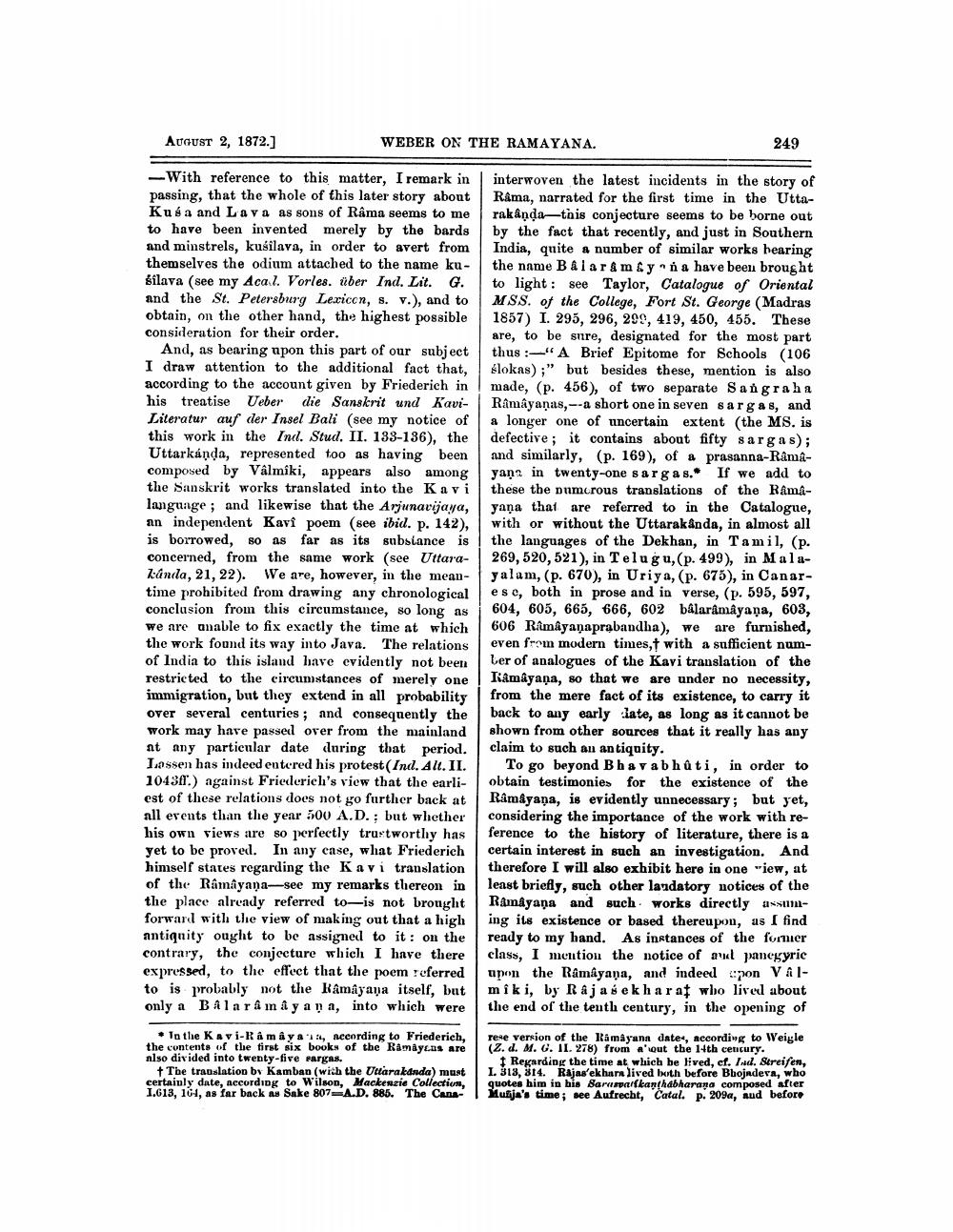________________
AUGUST 2, 1872.]
WEBER ON THE RAMAYANA.
249
-With reference to this matter, I remark in interwoven the latest incidents in the story of passing, that the whole of this later story about Ráma, narrated for the first time in the UttaKuba and Lava as sons of Râma seems to me rakanda—this conjecture seems to be borne out to have been invented merely by the bards by the fact that recently, and just in Southern and minstrels, kusilava, in order to avert from India, quite a number of similar works bearing themselves the odium attached to the name ku- the name Balaramay na have been brought silava (see my Acal. Vorles. über Ind. Lit. G. to light : see Taylor, Catalogue of Oriental and the St. Petersburg Lexicon, s. v.), and to MSS. of the College, Fort St. George (Madras obtain, on the other hand, the highest possible 1857) I. 295, 296, 299, 419, 450, 455. These consideration for their order.
are, to be sure, designated for the most part And, as bearing upon this part of our subject thus :-"A Brief Epitome for Schools (106 I draw attention to the additional fact that, slokas) ;" but besides these, mention is also according to the account given by Friederich in made, (p. 456), of two separate Sangraha his treatise Ueber die Sanskrit und Kavi- Râmâyaņas,--a short one in seven sargas, and Literatur auf der Insel Bali (see my notice of a longer one of uncertain extent (the MS. is this work in the Ind. Stud. II. 133-136), the defective; it contains about fifty sargas); Uttarkánda, represented too as having been and similarly, (p. 169), of a prasanna-Ramacomposed by Valmiki, appears also among yaņa in twenty-one sargas. If we add to the Sanskrit works translated into the Kavithese the numerous translations of the Ramalanguage ; and likewise that the Arjunavijaya, yana that are referred to in the Catalogue, an independent Kavi poem (see ibid. p. 142), with or without the Uttarakanda, in almost all is borrowed, so as far as its substance is the languages of the Dekhan, in Tamil, (p. concerned, from the same work (see Uttara- 269,520,521), in Telugu, (p. 499), in Malakanila, 21, 22). We are, however, in the mean- yalam, (p. 670), in Uriya, (p. 675), in Canartime prohibited from drawing any chronological esc, both in prose and in verse, (p. 595, 597, conclusion from this circumstance, so long as 604, 605, 665, 666, 602 bálarámâyaņa, 603, we are mmable to fix exactly the time at which 606 Ramayaņaprabandha), we are furnished, the work found its way into Java. The relations even from modern times, with a sufficient numof India to this island have evidently not been Ler of analogues of the Kavi translation of the restricted to the circumstances of merely one Kâmâyaņa, so that we are under no necessity, immigration, but they extend in all probability from the mere fact of its existence, to carry it over several centuries; and consequently the back to any early late, as long as it cannot be work may have passed over from the mainland shown from other sources that it really has any at any particular date during that period. claim to such an antiquity. Lossen has indeed entered his protest(Ind. Alt. II. To go beyond Bhavabhûti, in order to 1043f1.) against Friederich's view that the earli- obtain testimonies for the existence of the est of these relations does not go further back at Ramayana, is evidently unnecessary; but yet, all events than the year 200 A.D.; but whether considering the importance of the work with rehis own views are so perfectly trustworthy has ference to the history of literature, there is a yet to be proved. In any case, what Friederich certain interest in such an investigation. And himself states regarding the Kavi translation therefore I will also exhibit here in one "iew, at of the Ramayana—see my remarks thereon in least briefly, such other landatory notices of the the place already referred to—is not brought Ramayana and such works directly assumforward with the view of making out that a high ing its existence or based thereupon, as I find antiqnity ought to be assigned to it: on the ready to my hand. As instances of the former contrary, the conjecture which I have there class, I mention the notice of a panegyric expressed, to the effect that the poem oferred upon the Ramayana, and indeed upon VATto is probably not the Ramayana itself, but miki, by Rajasekhar at who lived about only a B Ala râm î y apa, into which were the end of the tenth century, in the opening of
To the Kavi-Ramaya'1 , nccording to Friederich, the contents of the first six books of the Ramayans are also divided into twenty-five rargas.
+ Tbe translation by Kamban (with the Uttarakdnda) must certainly date, according to Wilson, Mackenzie Collection, 1.613, 104. as far back As Sake 807A.D. 886. The Cana-
rese version of the Ramayana dates, according to Weigle (Z. d. M. G. II. 278) from a' out the 14th cencury.
Regarding the time at which he lived, cf. Ind. Streifen, 1. 313, 314. Rajas'ekhar lived both before Bhojndera, who quotes him in his Sarmallkanthabharaya composed after Mucija's time : see Aufrecht, Catal. p. 209a, Aud before




